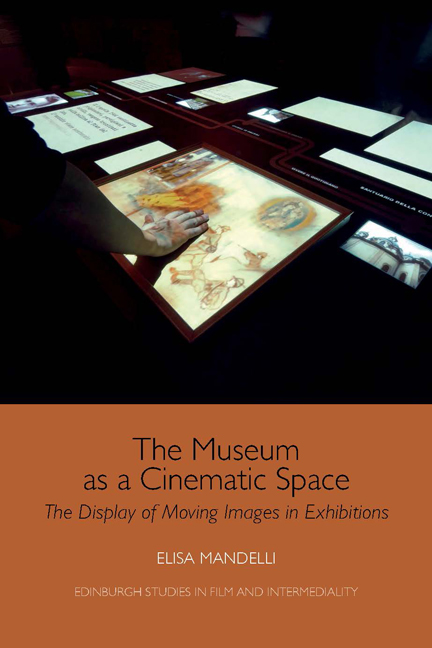Book contents
- Frontmatter
- Contents
- List of Figures
- Acknowledgements
- Preface
- Introduction
- Part I Between History and Modernity: Films in Exhibitions in the Twentieth Century
- Part II The Museum as a Cinematic Space: Museums and Moving Images in the Twenty-first Century
- 5 From the Museum Experience to the Museum as an Experience
- 6 Audio-visuals in Exhibitions
- 7 The Museum and its Spectres
- 8 A Walk through Images
- 9 New Interpretations of the Movie Theatre
- 10 Touching Images
- Conclusions
- Bibliography
- Index
7 - The Museum and its Spectres
from Part II - The Museum as a Cinematic Space: Museums and Moving Images in the Twenty-first Century
Published online by Cambridge University Press: 24 October 2019
- Frontmatter
- Contents
- List of Figures
- Acknowledgements
- Preface
- Introduction
- Part I Between History and Modernity: Films in Exhibitions in the Twentieth Century
- Part II The Museum as a Cinematic Space: Museums and Moving Images in the Twenty-first Century
- 5 From the Museum Experience to the Museum as an Experience
- 6 Audio-visuals in Exhibitions
- 7 The Museum and its Spectres
- 8 A Walk through Images
- 9 New Interpretations of the Movie Theatre
- 10 Touching Images
- Conclusions
- Bibliography
- Index
Summary
Cinema has always had a spectral dimension. Thanks to moving images, the figures on the screen could be brought back to life – an ambiguous and evanescent one that vanished with the fading out of the light cone. This spectral quality permeated not only the medium itself, but also its subjects: many films of the early cinema are about ghosts, from George Méliès’ Le manoir du diable (The House of the Devil) (1896) to George Albert Smith's Photographing a Ghost (1898). Although it does not directly feature ghosts, Émile Cohl's Fantasmagorie (1908), the first animated cartoon according to film historians, evokes in its title the late eighteenth- and nineteenth-century spectacular form known as Phantasmagoria. This connection suggests that, as Murray Leeder stated, ‘cinema's supernatural affinities stemmed as much from its continuities with previous media as its newness’.
Lynda Nead describes the unsettling power of early cinema through the metaphor of the ‘haunted gallery’, which she associates with other forms of expression such as painting and photography, all of which share the aim of animating motionless images. Cinematic images are thus inscribed in a tradition that runs from the myth of Pygmalion to Wilhelm Jensen's Gradiva (1903), and it is therefore no coincidence if early films often featured paintings coming to life.
As we have seen in Part I, one of the first functions of moving images in museums was precisely to animate – and therefore to bring back in motion – the items presented in a static form, much to the amazement of the viewers. Also, by virtue of their spectral (that is, evanescent yet ‘persistent’) nature, moving images in museums bring up forgotten or repressed episodes from the past, as well as painful or socially unacceptable traumas and experiences. Thus, the fascination of contemporary museums for ghost-like figures, often shown by means of moving images, has at least two facets. On the one hand, it is part of the generalised fascination for spectacular forms that characterises contemporary culture. On the other, the spectres haunting the museum rooms point to the institution's concerns about its own identity, social function, and way of connecting the past, present, and future.
- Type
- Chapter
- Information
- The Museum as a Cinematic SpaceThe Display of Moving Images in Exhibitions, pp. 91 - 104Publisher: Edinburgh University PressPrint publication year: 2019



